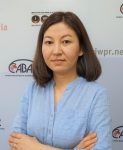On October 14, 2021, the IWPR CA team of researchers held a panel discussion at the Annual Conference of the Central Eurasian Studies Society (CESS) and presented the results of a content analysis of common COVID-19 fakes on social media in Kazakhstan, Kyrgyzstan, Uzbekistan, and Tajikistan.

 The research was conducted by the Representative office of the Institute for War & Peace Reporting» (IWPR) within the CABAR.asia Media School educational platform.
The research was conducted by the Representative office of the Institute for War & Peace Reporting» (IWPR) within the CABAR.asia Media School educational platform.
The in-depth analysis of 154 materials outlined the defining characteristics and features of COVID-19 fakes’ structure: their similarities and differences in comparison to other news materials, their format, channels and platforms of distribution, and distribution frequency. The analysis also examined at what stage the fakes were integrated in and became relevant in the region.
The goal of the research was to outline the key features of the most common COVID-19 fakes in the region by the content analysis method.
The research process was structured as an educational workshop: each country had a team of coders consisting of two lecturers and from three to five senior undergraduate and graduate students of journalism faculties, and head of research.
The objects of the research were coronavirus-related materials with the COVID-19 tag from the fact-checking resources Factcheck.kz (Kazakhstan), Factcheck.kg (Kyrgyzstan), and Fаctcheck.tj (Tajikistan) published from February 1 to October 31, 2020.
When collecting data for analysis in Uzbekistan, considering the relative similarity, the following resources were used: Poynter.org, Factcheck.kz, Factcheck.kg, and Factcheck.tj.

Opening the panel discussion, Karlyga Mysayeva, researcher from Kazakhstan, Candidate of Philology (PhD equivalent), Associate Professor in the Faculty of Journalism at Al-Farabi Kazakh National University, noted that from the database of COVID-19 fakes, the most popular topic in Kazakhstan was about self-treatment and coronavirus prevention. These fakes include simple solutions, groundless advice, or recipes shared in instant messengers. Despite numerous refutations, social media users continue to believe in the healing power of traditional folk medicines.

Jazgul Ibraimova, IWPR Central Asia Research Coordinator, presented an overview of the case of Kyrgyzstan. She noted that the first fakes appeared in the country’s internet segment back in January, and their number increased with the introduction of quarantine measures in March.
It is noteworthy that one fifth of all analysed fakes in Kyrgyzstan were related to government and country national policies in order to discredit them or undermine stability. Jazgul Ibraimova said this was related to the fact that the governments were unable to cope with the information flow due to the lack of strategies and abilities to provide timely reliable information and conduct explanatory work among the population.
Research and Analysis Consultant Katoen Faromuzova spoke about the widespread fakes in Tajikistan on the example of publications involving the interpretation and reposting of international studies. Such publications contain the distortion of the truth or incomplete information, including inaccurate translation from other languages, clickbait headlines to attract attention, or the government authorities and journalists’ ignorance about the features of the preprints of research and scientific experiments.
 In her presentation, researcher from Tajikistan Katoen Faromuzova emphasised that the ‘learning-by-doing’ method used in this research was effective and relevant both for improvement of future journalists’ training and building tutors’ thorough understanding of the topic. The feedback of research participants can be found in the “Educational Component” section. “Lack of official and timely information on important social phenomena gives strength to the environment of fakes,” added Katoen Faromuzova, researcher from Tajikistan, Research and Analysis Consultant.
In her presentation, researcher from Tajikistan Katoen Faromuzova emphasised that the ‘learning-by-doing’ method used in this research was effective and relevant both for improvement of future journalists’ training and building tutors’ thorough understanding of the topic. The feedback of research participants can be found in the “Educational Component” section. “Lack of official and timely information on important social phenomena gives strength to the environment of fakes,” added Katoen Faromuzova, researcher from Tajikistan, Research and Analysis Consultant.


Independent Research Analyst Nozima Davletova noted that in Uzbekistan, the popularity of fakes about governments and politics was directly proportional to the unpopularity of government measures in countering the coronavirus. These materials disseminated rumours about infections among families of state leaders, the ‘developers’ of the coronavirus infection, or efforts to impose mask wearing. A fake claiming that masks caused hypoxia was widespread and is still popular among many social media users. Comments on various posts attest to this. Davletova also highlighted that the analysis revealed that the absolute majority of sources were Russian-language websites, including those positioning themselves as news media. In addition, given our analysis, we assume that search engines such as Yandex, Mail.ru, or Google provide a possible organic channel for the distribution of fake/unverified materials from ‘.ru’ websites. Users do not normally disable news recommendations in search engines.

The participants of the panel discussion (most of them were representatives of the Association of American Universities) expressed great interest in the presented analysis and asked how it was possible to counter fakes together with local leaders and local authorities. The panelists responded that, unfortunately, the level of critical thinking and awareness was low in the region, including among opinion leaders.
 Moderator of the discussion Jatin Srivastava, Associate Professor at E.W. Scripps School of Journalism at Ohio University, noted that the panel generated good audience engagement and audience questions played important role in driving the discussion.
Moderator of the discussion Jatin Srivastava, Associate Professor at E.W. Scripps School of Journalism at Ohio University, noted that the panel generated good audience engagement and audience questions played important role in driving the discussion.
You can download the full version of the content analysis here.

